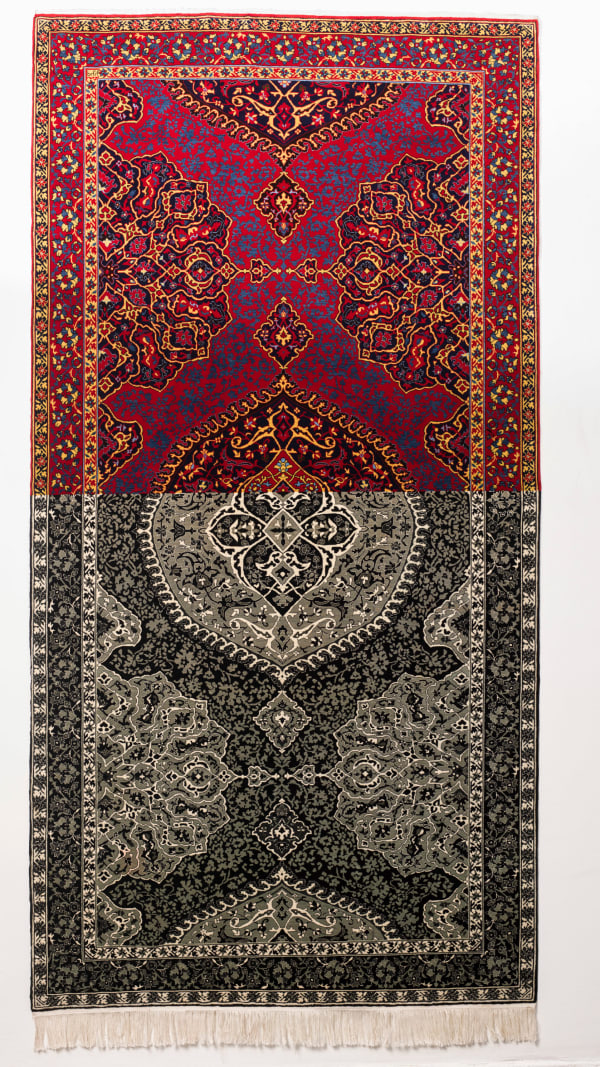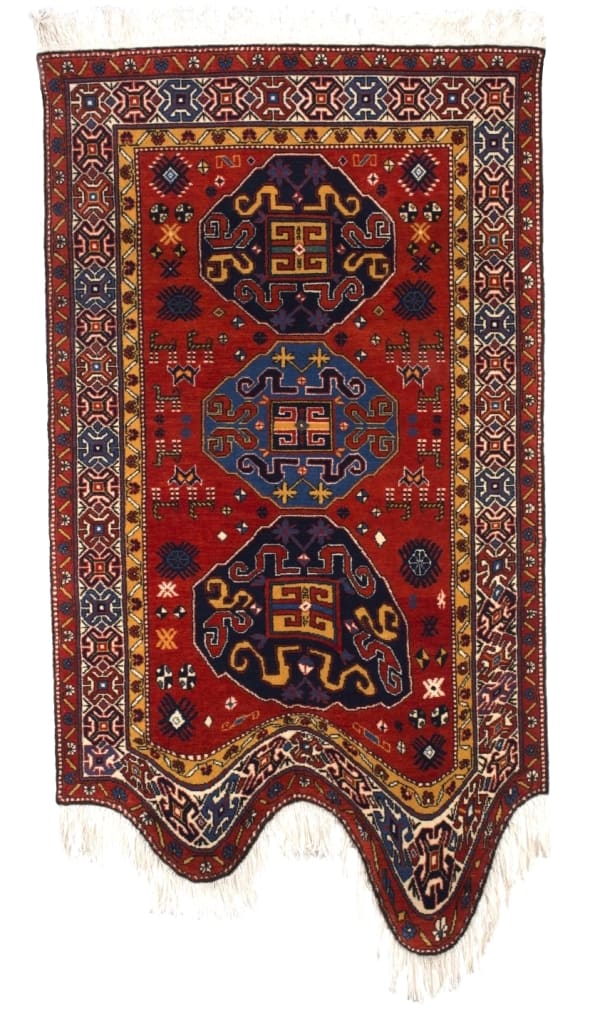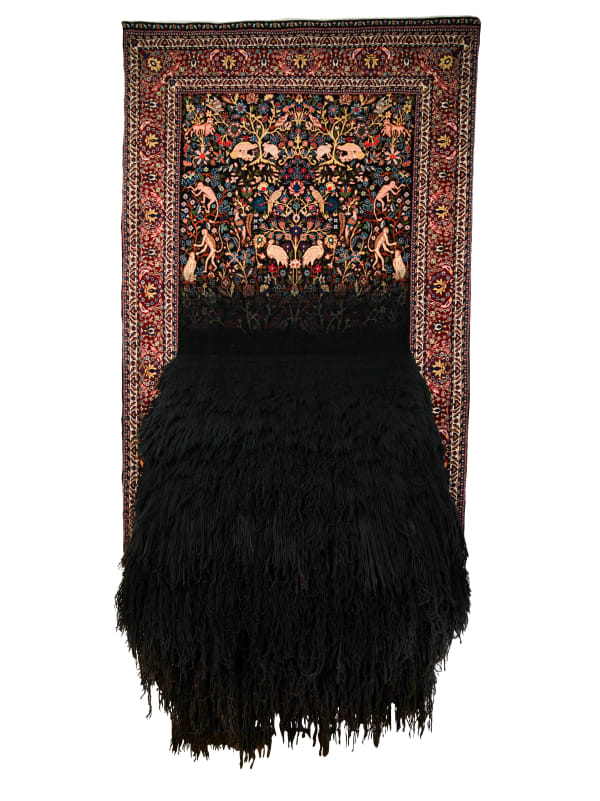-

-
 The Knot, 2024. Handmade wool and silk carpet, Variable Dimension, 36 5/8 x 235 in (open), 93 x 597 cm. AP
The Knot, 2024. Handmade wool and silk carpet, Variable Dimension, 36 5/8 x 235 in (open), 93 x 597 cm. AP -
In Ahmed’s mathematical rug series (The Constants Pattern), the artist creates carpets based on mathematical constants — the numbers Phi (φ), Pi (π), and e (e) — the laws by which the cosmos pulses. These works emphasize the convergence of science and mysticism – each curve, line, and form on these carpets come together to produce the Universe’s vocabulary, one that stretches from the rituals of ancient temples to the digital age. Building from a West and Central Asian tradition, which extends from Azerbaijan, Iran, and beyond, Ahmed approaches the carpet as a series of knots and patterns that contain mathematical precision and open unto a larger cosmological universe that contains narratives, poetry, architecture and art. Breaking away from the binary between craft and art object, Ahmed’s conceptual unraveling of the carpet challenges the viewer to reflect on the carpet as a medium that carries its own relationship to time, space, language, and perceptive experience.
-
Faig Ahmed (Sumqayit, 1982) lives and works in Baku, Azerbaijan and graduated from the sculpture department of Azerbaijan State Academy of Fine Art in 2004. He represented Azerbaijan at the nation’s inaugural pavilion at the Venice Biennale in 2007 and participated in the show “Love Me, Love Me Not” in 2013. He is well known for his conceptual works that transform traditional decorative craft and the visual language of carpets into contemporary sculptural works of art. His art reimagines ancient crafts and create new visual boundaries by deconstructing traditions and stereotypes. Ahmed is among a new wave of contemporary artists exploring crafts in innovative ways to produce conceptual works that break away from conventions associated with the craft, by bringing it into a global contemporary art context.
Museum Collections
Ahmed’s works can be seen in public collections globally, including the Art Institute of Chicago, Los Angeles County Museum, Palm Springs Art Museum, Seattle Art Museum, RISD Museum of Art, Chrysler Museum of Art, George Washington University, Brooks Museum of Art, Memphis, TN; Currier Museum of Art, NH; Bargoin Museum, France; MOCAK Museum of Contemporary Art, Krakow, Poland; The National Gallery of Victoria, Australia; Arsenal art Contemporain Montréal, Canada; The National Museum of Art, Architecture and Design, Norway, Istanbul Modern and the Museum of Fine Arts, Houston, TX.
His work has also been placed in private and institutional collections such as the West Collection, Philadelphia; the Microsoft Art Collection, Wake Forest University, the collection of Beth Rudin DeWoody, New York; Galila’ Collection, Brussels; Ranza collection, Rome; Jameel Foundation, Espacio SOLO, Puerta de Alcalá, Madrid; London and H.H. Sheikh Zayed bin Sultan bin Khalifa Al Nahyan, UAE.
-
Faig Ahmed, a student of modern and ancient languages, including Sanskrit and Arabic, was interested in the origin of languages and human writing long before he became interested in carpets. It was his study of pre-historic petroglyphs that led to his fascination with the language of carpet patterns. Ahmed re-imagines carpets as a source code for visual communication, writing, design, art and even science.
During the past decade, Ahmed has become internationally known for re-interpreting the coded messages in ancient carpet designs. His artwork speaks about the unconscious power of the visual language of patterns that communicates messages through generations and cultures, and links early human history with the digital age. By disrupting and re-imagining the visual code and structure of the rugs that were developed over the centuries in Caucasus, Turkey, Persia and India, Ahmed suggests new ideas about the nature of reality and the limits of human perception.
-
-
-

-
For Ahmed, the carpet is a metaphor for creation, bursting with life and full of human stories and emotions, always evolving. His carpets also burst with stories and emotions. He refers to them as ‘cultural geographies’ with distinct histories, personalities, and languages spun within their threads and interwoven in their designs and colours. Faig can be described as a cultural iconoclast. He willfully breaks down and questions long-established and accepted forms and boundaries. During this process, which at times is purposeful and at other times in the realm of his subconscious, he creates powerful and compelling artworks underpinned by his new conceptual framework.
-

-
Ahmed's works are conceived with complex layers of historical, literary, mystical, and craft associations. He works closely with his female weavers throughout the process of making as he recognizes and respects the creative power of the women who harness their ancestral knowledge of carpet weaving which has withstood the test of time despite over 70 years of political upheaval and restrictions faced in Azerbaijan during Soviet rule. Through his art, Ahmed is on a journey of self-reflection and discovery to piece together the many facets of his identity, past and present.
-
-
 Faig Ahmed (Azerbaijan)Cosmos , 2021Handmade wool carpet60 x 106 in
Faig Ahmed (Azerbaijan)Cosmos , 2021Handmade wool carpet60 x 106 in
152.4 x 269.2 cm -
 Faig Ahmed (Azerbaijan)Decoherence , 2023Handmade woolen carpet39 x 85 3/8 x 51 1/8 in
Faig Ahmed (Azerbaijan)Decoherence , 2023Handmade woolen carpet39 x 85 3/8 x 51 1/8 in
99 x 217 x 130 cm
(130 is the widest part) -
 Faig Ahmed (Azerbaijan)Suraxani Pink, 2023Handmade woolen carpet
Faig Ahmed (Azerbaijan)Suraxani Pink, 2023Handmade woolen carpet
39 3/4 x 76 3/4 in
101 x 195 cm -
 Faig Ahmed (Azerbaijan)Microsynthetic, 2023Handmade woolen carpet
Faig Ahmed (Azerbaijan)Microsynthetic, 2023Handmade woolen carpet
39 x 74 in
99 x 188 cm
-
-
Exhibitions
Ahmed has exhibited his works worldwide including group and solo exhibitions in New York, Paris, London, Berlin, Rome, Venice, Dubai, Washington D.C., Hong Kong, Mumbai, Moscow, Azerbaijan, Sweden, Norway, Honolulu, Melbourne, and Sydney. In the past few years, Ahmed’s works have been exhibited in several museums including the Museum of Fine Art Boston, Los Angeles County Museum, Bellevue Art Museum, Milwaukee Institute of Art & Design, MOCA Cleveland, Museum of Old and New Art, Tasmania, Pennsylvania College of Art and Design, Shangri La Museum of Islamic Art, NYU Abu Dhabi, the Textile Museum of Sweden, the Projective Eye Gallery at UNC Charlotte, and many others. The artist was nominated for the Jameel Prize 3 at the Victoria and Albert Museum in London. Ahmed’s upcoming museum exhibitions include shows at The Aga Khan Museum, the New Tretyakov Gallery, and in Istanbul Modern.
Current viewing_room














